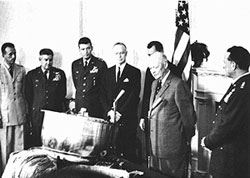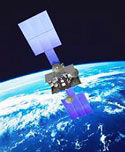May 2008 Edition
The Military Market
Priority Briefings
PRIORITY BRIEFING - General Michael Hamel, Commander, Space & Missile Command, Los Angeles AFB, El Segundo, CA
PRIORITY BRIEFING - Brigadier General Ellen M. Pawlikowski, Vice Commander, Space and Missile Systems Center, Los Angeles AFB, El Segundo, California
PRIORITY BRIEFING - General James Armor (Ret.), Member, Board of Directors, Integral Systems, Inc.
Now retired from a highly successful career in the airforce, General Armor discusses his former role in the armed forces, and his present position on the board of Integral Systems.
Features
The SWaP Meet,
Size, weight and power, or “SWaP” in military parlance, is being reduced both at the terminal level and the individual networking device to more effectively provide COTM capabilities. These trends are compelling satcom vendors to make some bold R&D investments in new and emerging technologies, and develop a new generation of satellite products to meet the requirements of the modern mobile warfighter.
Military Satellite Systems: A History — Part One,
The Space and Missile Systems Center traces its ancestry back to the Western Development Division (WDD) of the Air Research and Development Command (ARDC). WDD was activated on July 1, 1954 and was redesignated the Air Force Ballistic Missile Division (AFBMD) on June 1, 1957.

Focus On
FOCUS ON: Space Tracking and Surveillance System, Excerpted from the Department of Defense’s Missile Defense Agency’s STSS Fact Sheet and their BMDS Booklet entitled “Missile Defense—Worldwide”
FOCUS ON - TSAT Technology is Mature , Ready for Development Phase
by TSAT Program Staff
 The Transformational Satellite Communications System (TSAT)—a system that is being designed to introduce technologies that will address warfighter needs 10-15 years from now—implemented a back-to-basics approach and successfully matured key technologies to a level that will ensure success on this vital satellite system.
The Transformational Satellite Communications System (TSAT)—a system that is being designed to introduce technologies that will address warfighter needs 10-15 years from now—implemented a back-to-basics approach and successfully matured key technologies to a level that will ensure success on this vital satellite system.
Executive Spotlight
EXECUTIVE SPOTLIGHT ON... Gregory Smolka, Vice President, Industrial, Military and Space, Vectron International
Gregory L. Smolka is responsible for growing Vectron’s strong market positions in test and measurement, medical imaging, process control and other industrial applications while reinforcing the company’s leadership position in defense and space markets.
Regular Departments

